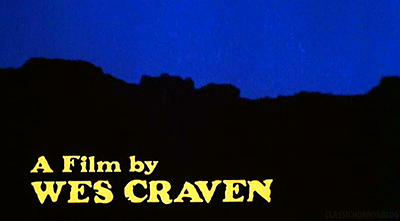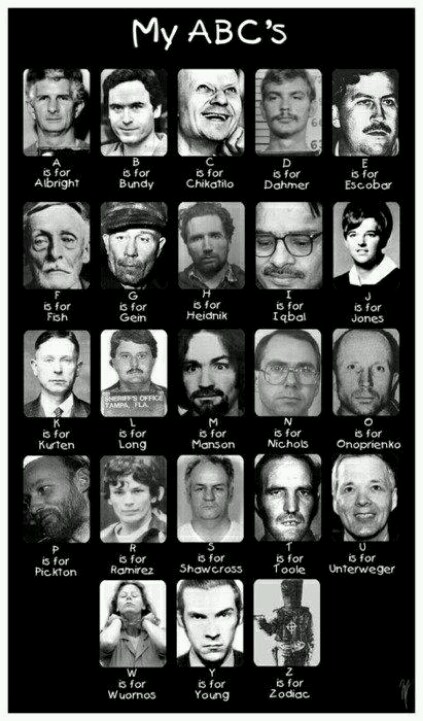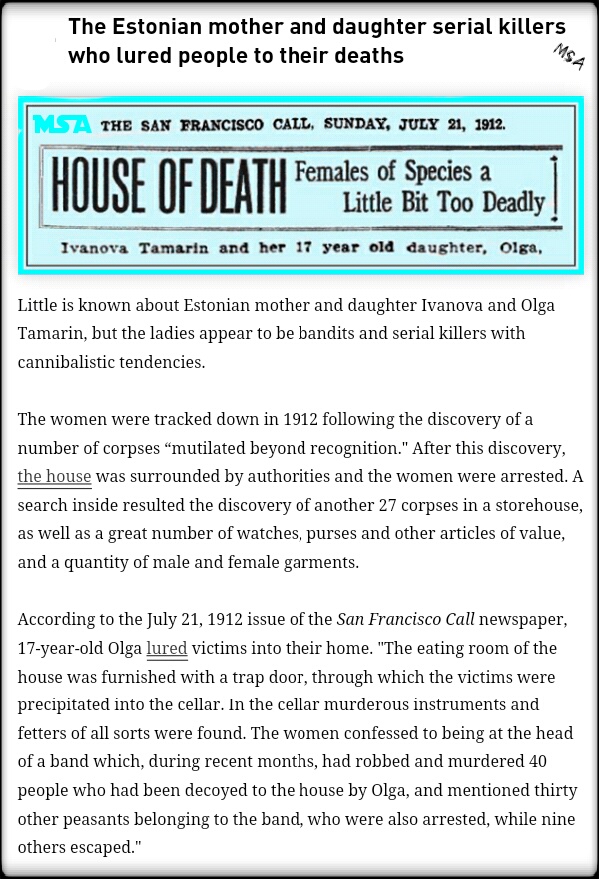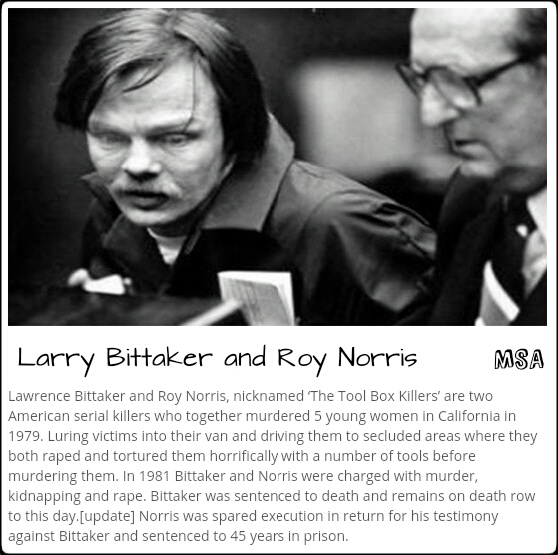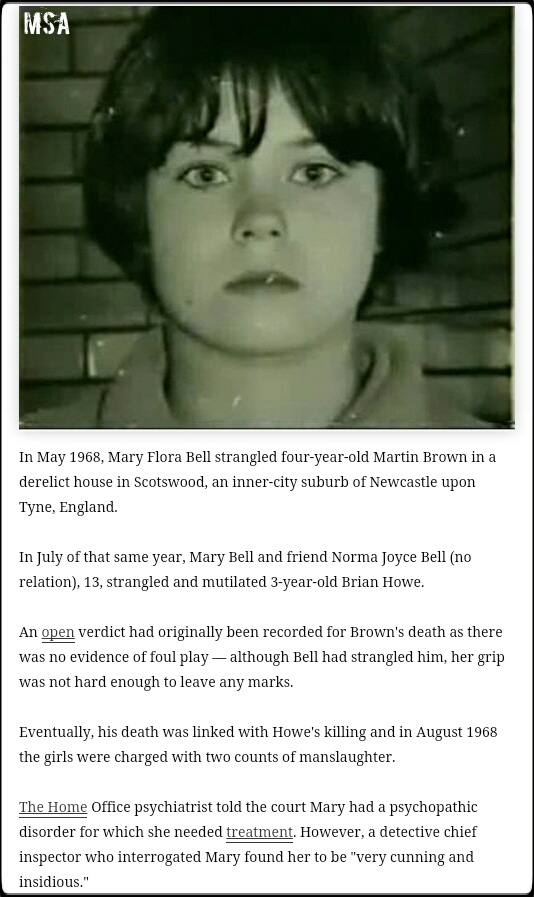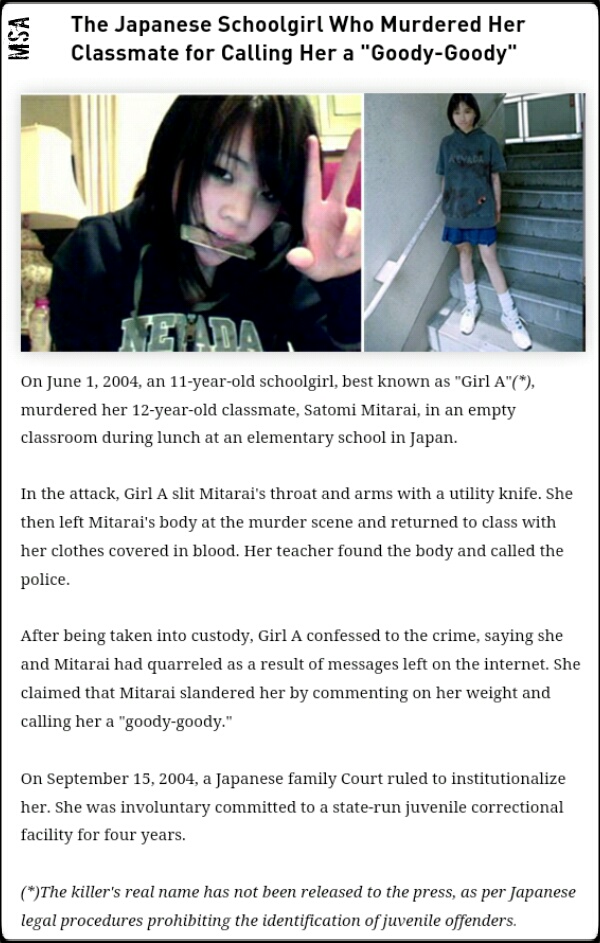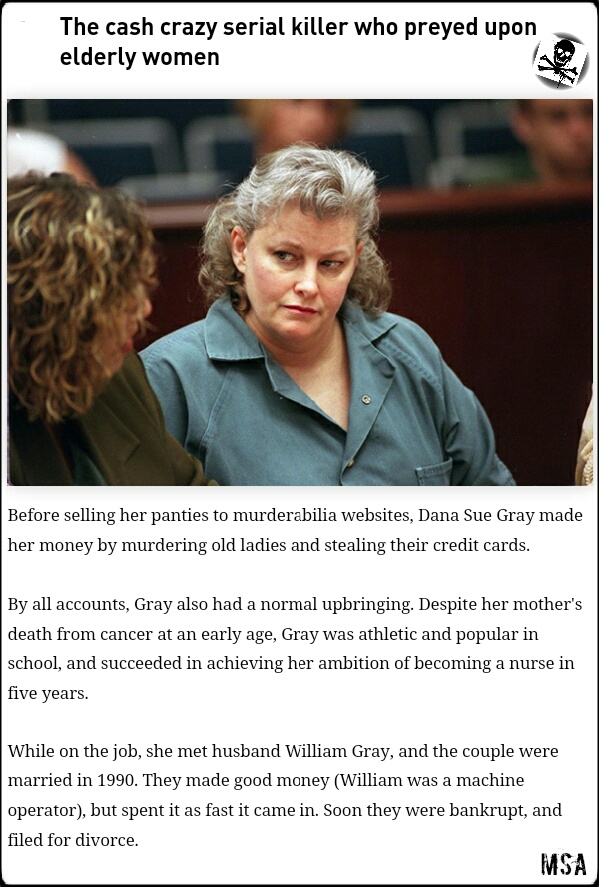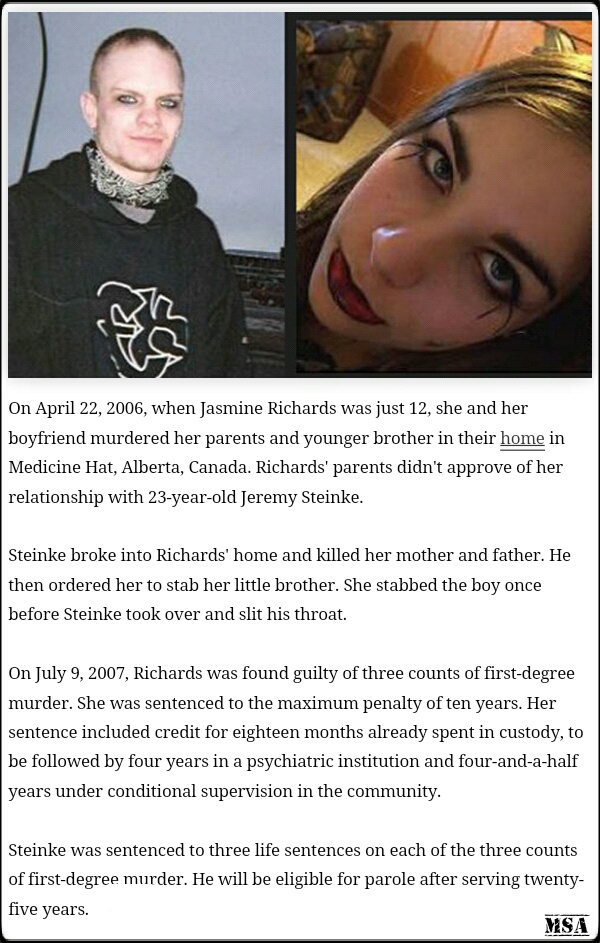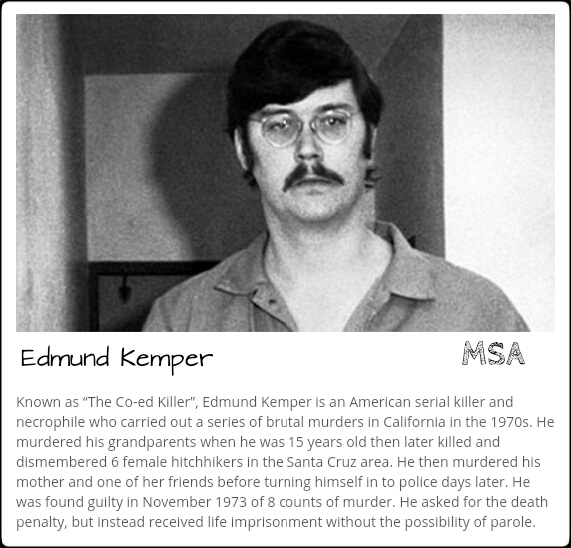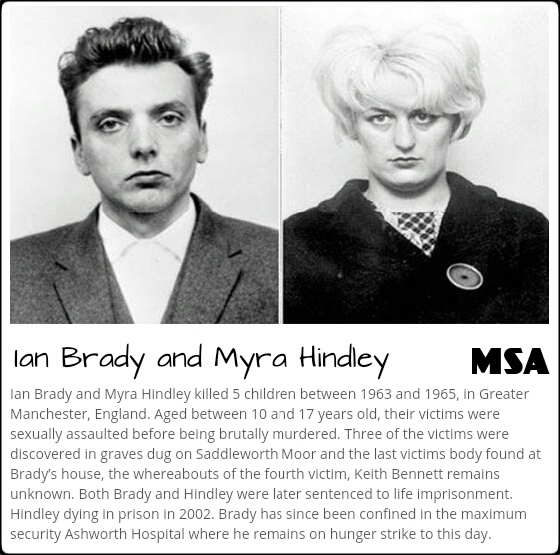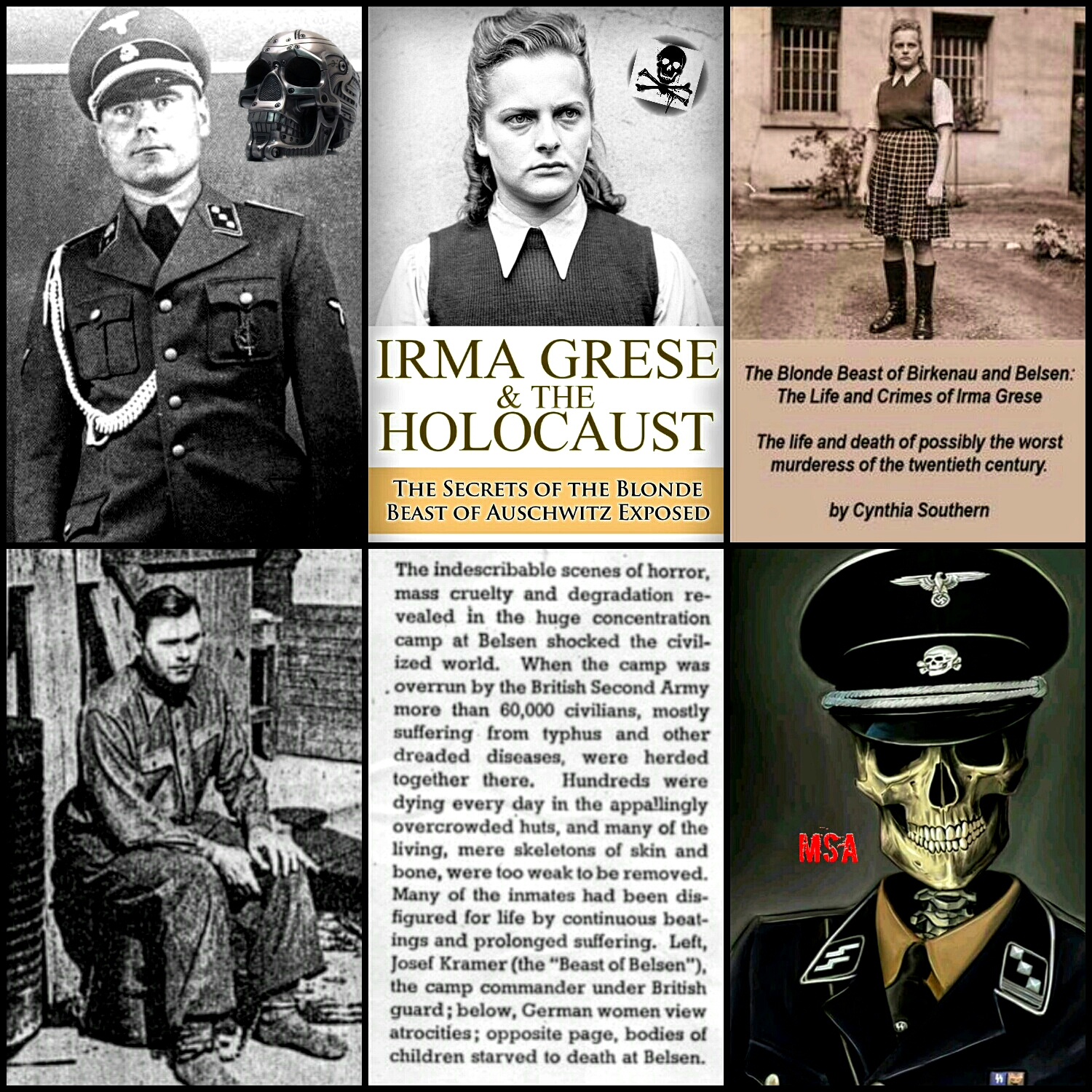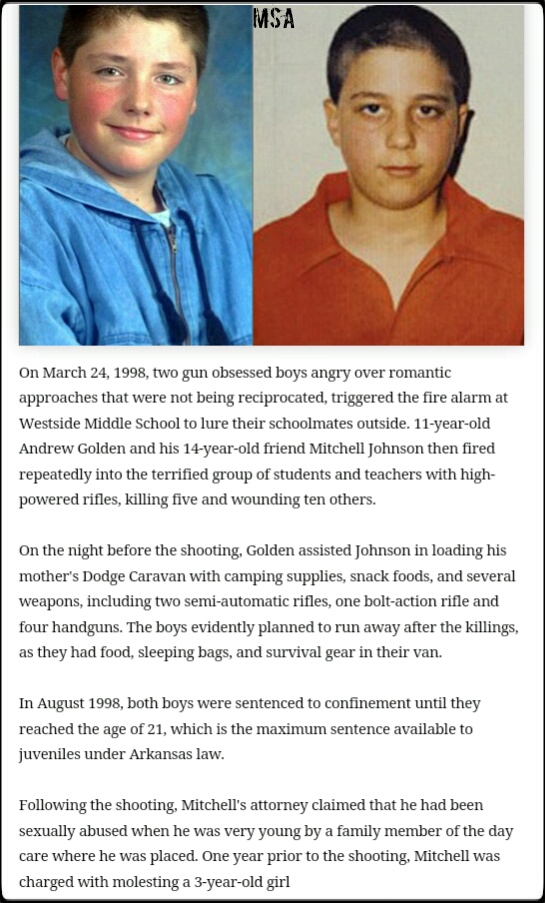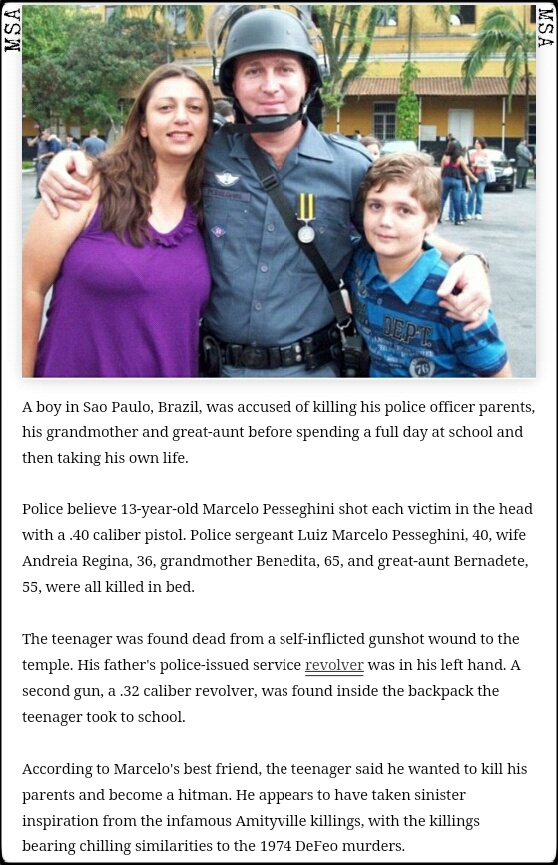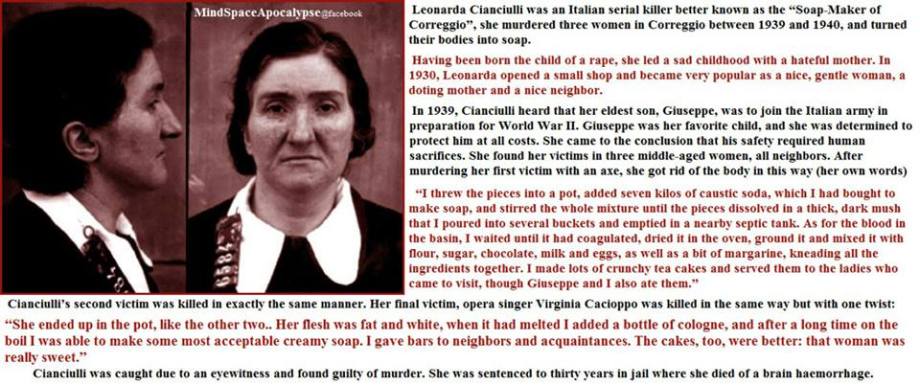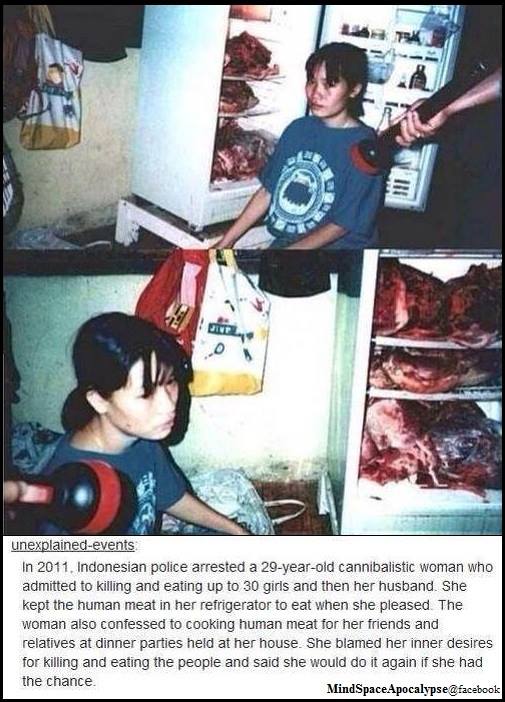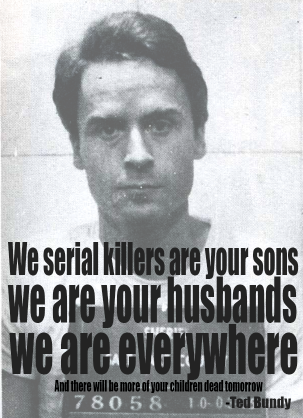 http://extra.listverse.com/amazon/recordings2/Ted%20Bundy%20Confession%20Tapes.mp3
http://extra.listverse.com/amazon/recordings2/Ted%20Bundy%20Confession%20Tapes.mp3
 *Kitty Genovese Murder Shocks the World. - In a murder that shocked the nation and the world, and called into question the willingness and ability of the public to help those in distress, Catherine Susan (Kitty) Genovese was stabbed to death as she was returning to her Queens, New York City home in the early morning hours of Friday March 13, 1964. She was only 29 years old. Two weeks after the murder, a newspaper article appeared that questioned whether or not neighbors heard the attack and stood by and did nothing to help the girl. Later this was called into question, but not before the murder of Kitty Genovese and the investigation brought to light a social psychological phenomenon called “diffusion of responsibility” or “the bystander effect” (or the “Genovese syndrome”). Genovese was returning from the bar where she worked as a manager, around 3:15 AM in the morning and parked her car only 100 feet from her house. While walking in an alley to get home, she was attacked by Winston Mosely. Genovese ran away but Mosely took chase, caught her, and stabbed her twice in the back. She screamed “oh my God, he stabbed me!” and this was apparently heard by many neighbors, but only one of them, Robert Mozer opened his window and screamed at Mosley “let that girl alone!” This frightened Mosley and he fled. Genovese slowly moved towards her apartment building. People called the police to report the attack but the police were slow to respond. Meanwhile, Mosely went to his car, disguised himself, and went back to search for Genovese. He found her, at the back of a hallway leading to her apartment; she was unable to enter her apartment, too weak from the initial attack. Out of view, he proceeded to stab her several more times, then raped her as she was dying. The attack spanned at least a half an hour. She died en route to the hospital in the ambulance. Originally the newspaper reported 38 people heard or saw the attack, but this is certainly an exaggeration. Still, at least a dozen people witnessed the attack, most mistaking it for a quarrel between lovers, or a drunken street brawl by youths. Mosely was arrested and admitted to the crime, he said he liked to kill women because they put up less of a fight. On that night he left his wife sleeping in bed and went out on the hunt, he spotted Genovese and moved in for the kill. Mosely was found guilty of murder and sentenced to death, but this was later changed to life in prison. The public saw the murder of Genovese as symptomatic of the moral decay and apathy present in New York City and all major cities at that time, and people in general.
*Kitty Genovese Murder Shocks the World. - In a murder that shocked the nation and the world, and called into question the willingness and ability of the public to help those in distress, Catherine Susan (Kitty) Genovese was stabbed to death as she was returning to her Queens, New York City home in the early morning hours of Friday March 13, 1964. She was only 29 years old. Two weeks after the murder, a newspaper article appeared that questioned whether or not neighbors heard the attack and stood by and did nothing to help the girl. Later this was called into question, but not before the murder of Kitty Genovese and the investigation brought to light a social psychological phenomenon called “diffusion of responsibility” or “the bystander effect” (or the “Genovese syndrome”). Genovese was returning from the bar where she worked as a manager, around 3:15 AM in the morning and parked her car only 100 feet from her house. While walking in an alley to get home, she was attacked by Winston Mosely. Genovese ran away but Mosely took chase, caught her, and stabbed her twice in the back. She screamed “oh my God, he stabbed me!” and this was apparently heard by many neighbors, but only one of them, Robert Mozer opened his window and screamed at Mosley “let that girl alone!” This frightened Mosley and he fled. Genovese slowly moved towards her apartment building. People called the police to report the attack but the police were slow to respond. Meanwhile, Mosely went to his car, disguised himself, and went back to search for Genovese. He found her, at the back of a hallway leading to her apartment; she was unable to enter her apartment, too weak from the initial attack. Out of view, he proceeded to stab her several more times, then raped her as she was dying. The attack spanned at least a half an hour. She died en route to the hospital in the ambulance. Originally the newspaper reported 38 people heard or saw the attack, but this is certainly an exaggeration. Still, at least a dozen people witnessed the attack, most mistaking it for a quarrel between lovers, or a drunken street brawl by youths. Mosely was arrested and admitted to the crime, he said he liked to kill women because they put up less of a fight. On that night he left his wife sleeping in bed and went out on the hunt, he spotted Genovese and moved in for the kill. Mosely was found guilty of murder and sentenced to death, but this was later changed to life in prison. The public saw the murder of Genovese as symptomatic of the moral decay and apathy present in New York City and all major cities at that time, and people in general.
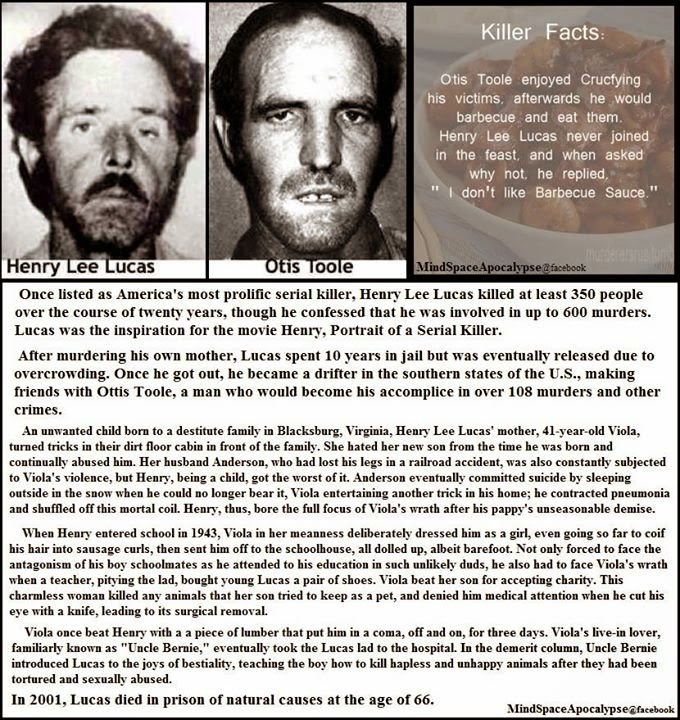
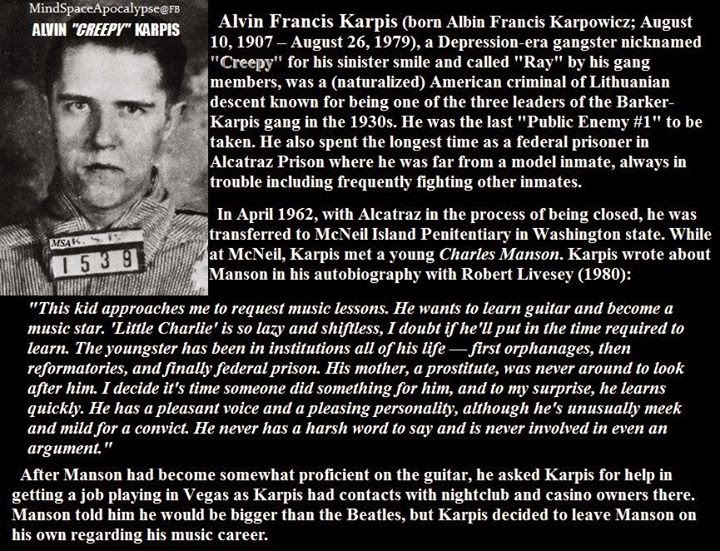
 This man attacked and started biting another passenger out of nowhere.
This man attacked and started biting another passenger out of nowhere.
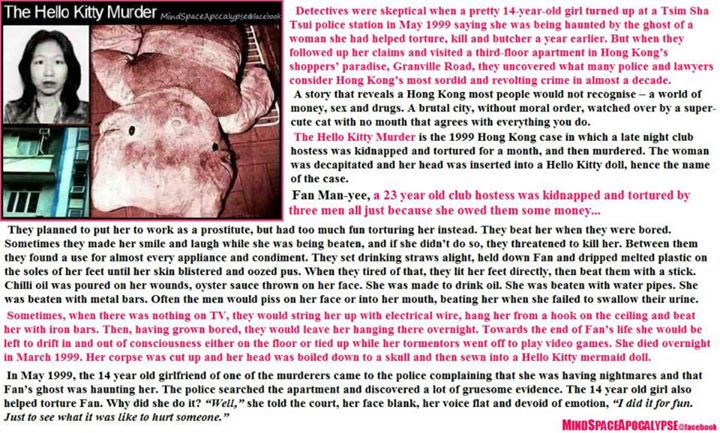
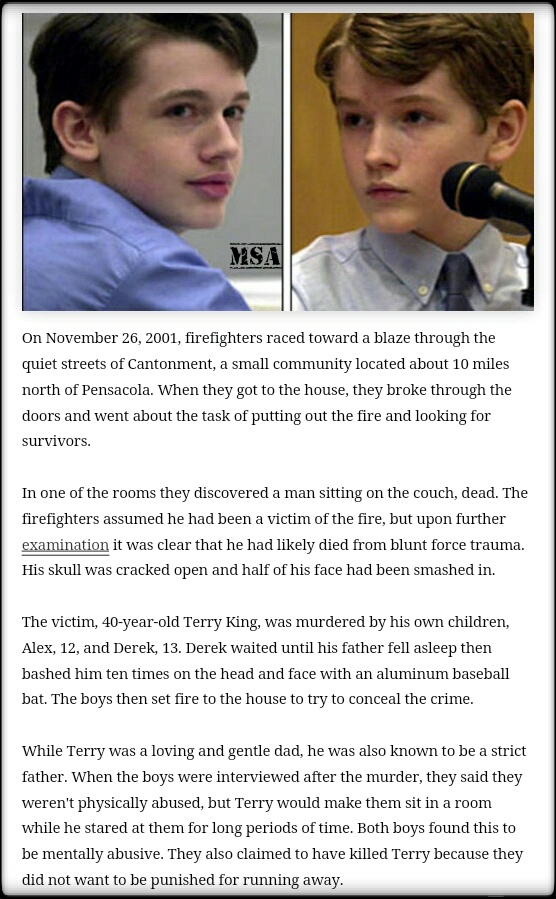
 (Issei Sagawa - continued from pic, worth reading) - Sagawa said he fainted after the shock of shooting her, but awoke with the realization that he had to carry out his plan. He did so, beginning with her buttocks and thighs, after having sex with the corpse. In interviews, he noted his surprise at the "corn-colored" appearance of human fat. For two days, Sagawa ate various parts of the body. He described the meat as tasting like raw tuna. He then attempted to dump the mutilated body in a remote lake, but was seen in the act and later arrested by French police, who found parts of the deceased still in his refrigerator. - Sagawa's wealthy father provided a lawyer for his defense, and after being held for two years without trial Sagawa was found legally insane and unfit to stand trial by the French judge Jean-Louis Bruguière, who ordered him held indefinitely in a mental institution. After a visit by the author Inuhiko Yomota, Sagawa's account of the murder was published in Japan under the title In the Fog. Sagawa's subsequent publicity and macabre celebrity likely contributed to the French authorities' decision to have him extradited to Japan. Upon arrival in Japan, he was immediately taken to Matsuzawa hospital, where examining psychologists all found him to be sane, stating that sexual perversion was the sole motivation for the murder. Japanese authorities found it legally impossible to detain him because the French government refused to release court documents (which remain secret) to Japan, claiming that the case had already been dropped in France. As a result, Sagawa checked himself out of the mental institution on August 12, 1986, and has been a free man ever since. Sagawa's freedom has been questioned and criticized by many.
(Issei Sagawa - continued from pic, worth reading) - Sagawa said he fainted after the shock of shooting her, but awoke with the realization that he had to carry out his plan. He did so, beginning with her buttocks and thighs, after having sex with the corpse. In interviews, he noted his surprise at the "corn-colored" appearance of human fat. For two days, Sagawa ate various parts of the body. He described the meat as tasting like raw tuna. He then attempted to dump the mutilated body in a remote lake, but was seen in the act and later arrested by French police, who found parts of the deceased still in his refrigerator. - Sagawa's wealthy father provided a lawyer for his defense, and after being held for two years without trial Sagawa was found legally insane and unfit to stand trial by the French judge Jean-Louis Bruguière, who ordered him held indefinitely in a mental institution. After a visit by the author Inuhiko Yomota, Sagawa's account of the murder was published in Japan under the title In the Fog. Sagawa's subsequent publicity and macabre celebrity likely contributed to the French authorities' decision to have him extradited to Japan. Upon arrival in Japan, he was immediately taken to Matsuzawa hospital, where examining psychologists all found him to be sane, stating that sexual perversion was the sole motivation for the murder. Japanese authorities found it legally impossible to detain him because the French government refused to release court documents (which remain secret) to Japan, claiming that the case had already been dropped in France. As a result, Sagawa checked himself out of the mental institution on August 12, 1986, and has been a free man ever since. Sagawa's freedom has been questioned and criticized by many.
[youtube https://www.youtube.com/watch?v=QlYuVNb7xMg&w=540&h=331]
[caption id="attachment_3887" align="aligncenter" width="620"] MindSpaceApocalypse@facebook[/caption]
MindSpaceApocalypse@facebook[/caption]
H.H. Holmes and the Murder Castle:
Herman Webster Mudgett (May 16, 1861 – May 7, 1896), better known under the name of Dr. Henry Howard Holmes or just H. H. Holmes, was one of the first documented serial killers in the modern sense of the term. In Chicago at the time of the 1893 World's Columbian Exposition, Holmes opened a hotel which he had designed and built for himself specifically with murder in mind, and which was the location of many of his murders. While he confessed to 27 murders, of which nine were confirmed, his actual body count could be over 200. He brought an unknown number of his victims to his World's Fair Hotel, located about 3 miles (4.8 km) west of the fair.
The case was notorious in its time and received wide publicity through a series of articles in William Randolph Hearst's newspapers. Interest in Holmes's crimes was revived in 2003 by Erik Larson's The Devil in the White City: Murder, Magic, and Madness at the Fair That Changed America,
a best-selling non-fiction book that juxtaposed an account of the planning and staging of the World's Fair with Holmes's story.
 His story had been previously chronicled in The Torture Doctor by David Franke (1975), Depraved: The Shocking True Story of America's First Serial Killer by Harold Schechter (1994), and Chapter VI "The Monster of Sixty-Third Street" of Gem of the Prairie: An Informal History of the Chicago Underworld by Herbert Asbury (1940, republished 1986).
His story had been previously chronicled in The Torture Doctor by David Franke (1975), Depraved: The Shocking True Story of America's First Serial Killer by Harold Schechter (1994), and Chapter VI "The Monster of Sixty-Third Street" of Gem of the Prairie: An Informal History of the Chicago Underworld by Herbert Asbury (1940, republished 1986).
Mudgett was born in Gilmanton, New Hampshire, on May 16, 1861, to Levi Horton Mudgett and Theodate Page Price, both of whom were descended from the first European settlers in the area. Mudgett was his parents' third-born child; he had an older sister Ellen, an older brother Arthur, and a younger brother Henry. Mudgett's father was a farmer from a farming family, and his parents were devout Methodists. According to the 2007 Most Evil profile on Holmes, his father was a violent alcoholic. Mudgett claimed that, as a child, some of his classmates forced him into the doctor's office to stand face to face with a human skeleton after discovering his fear of the local doctor. The bullies initially took him there to scare him, but Erik Larson speculates that instead he was utterly fascinated, and he soon became obsessed with death. On July 4, 1878, Mudgett married Clara Lovering in Alton, New Hampshire; their son, Robert Lovering Mudgett, was born on February 3, 1880, in Loudon, New Hampshire. (As an adult, Robert was to become a certified public accountant, and served as city manager of Orlando, Florida.)
In 1882, Mudgett entered the University of Michigan's Department of Medicine and Surgery and graduated in June 1884 after passing his examinations. While enrolled, he stole bodies from the laboratory, disfigured the bodies, and claimed that the people were killed accidentally in order to collect insurance money from policies he took out on each deceased person. He left his wife and son to move to Chicago and began a career in pharmaceuticals. It was also at this time that Mudgett began engaging in many shady businesses, real estate, and promotional deals under the name "H.H. Holmes."
On January 28, 1887, while he was still married to Clara, Holmes married Myrta Belknap (b. October 1862 in Pennsylvania) in Minneapolis, Minnesota. He filed for divorce from Clara a few weeks after marrying Myrta, but the divorce was never finalized. Holmes had a daughter with Myrta, Lucy Theodate Holmes, who was born on July 4, 1889, in Englewood, Illinois (as an adult, Lucy became a public schoolteacher). Holmes lived with Myrta and Lucy inWilmette, Illinois, and spent most of his time in Chicago tending to business.
Holmes married Georgiana Yoke on January 17, 1894, in Denver,Colorado, while still married to Clara and Myrta.[citation needed] He also had a relationship with Julia Smythe, the wife of one of his former employees. Julia would later become one of Holmes's victims.
Chicago and the "Murder Castle"
Holmes arrived in Chicago in August 1886 and came across Dr. Elizabeth S. Holton's drugstore at the northwest corner of S. Wallace Avenue and W. 63rd Street in the Chicago neighborhood. Holton gave Holmes a job, and he proved himself to be a hardworking employee. After the death of Holton's husband, Holmes offered to buy the drugstore from Holton, and she agreed. Holmes purchased the store mainly with funds obtained by mortgaging the store's fixtures and stock, the loan to be repaid in substantial monthly installments of one hundred dollars (worth $2,600 today).
Holmes purchased a lot across from the drugstore where he
built his three-story, block-long "castle" as it was dubbed by those in the neighborhood. The address of the Castle was 601-603 W. 63rd St. It was called the World's Fair Hotel and opened as a hostelry for the World's Columbian Exposition in 1893, with part of the structure devoted to commercial space. The ground floor of the Castle contained Holmes' own relocated drugstore and various shops, while the upper two floors contained his personal office and a maze of over 100 windowless rooms with doorways opening to brick walls, oddly-angled hallways, stairways leading to nowhere, doors that can only be opened from the outside, and a host of other strange and labyrinthine constructions. Holmes was constantly firing and hiring different workers during the construction of the Castle, so that only he fully understood the design of the building.
During the period of building construction in 1889, Holmes met Benjamin Pitezel, a carpenter with a past of lawbreaking, with whom Holmes became close friends. He used Pitezel as his right-hand man for his criminal schemes. A district attorney later described Pitezel as Holmes' "tool . . . his creature."
After the completion of the hotel, Holmes selected mostly female victims from among his employees (many of whom were required as a condition of employment to take out life insurance policies, for which Holmes would pay the premiums but was also the beneficiary), as well as his lovers and hotel guests, whom he would later kill. Some were locked in soundproof bedrooms fitted with gas lines that let him asphyxiate them at any time. Holmes would also lock his victims in a room where the walls were covered with iron plates and had blowtorches installed to incinerate them. One of the rooms on the second floor was called the "secret hanging chamber"; Where Holmes would take one of his victims and have them lynched. Other victims were locked in a huge soundproof bank vault near his office, where they were left to suffocate.[8] The victims' bodies were dropped by a secret chute to the basement,[3] where some were meticulously dissected, stripped of flesh, crafted into skeleton models, and then sold to medical schools. Holmes also buried some of the bodies inlime pits for disposal. Holmes had two giant furnaces used to incinerate some of the bodies or evidence, as well as pits of acid, bottles of various poisons, and even a stretching rack. Through the connections he had gained in medical school, he sold skeletons and organs with little difficulty.
One victim was lover Julia Smythe, who was the wife of Ned Conner who, after moving into Holmes' building, started working at his pharmacy's jewelry counter. In 1891, Julia became pregnant with Holmes' child. After finding out, Holmes agreed to marrying her, but told her that they couldn't have a child. She consented to have him perform an abortion. The abortion was planned for Christmas Eve. Holmes murdered Julia by overdosing her with chloroform and later killed her daughter Pearl. Holmes called a friend to help dispose of her body and when confronted by a tenant in the building questioning where Julia and her daughter were, Holmes said they left for Iowa for a family wedding.
Another victim was Minnie Williams. Holmes rekindled a relationship with Minnie, allowing him to get close to another victim of his, her sister Anna. Holmes informed Anna that they were ready to go on their vacation, then locked her in the vault in the pharmacy where she cried for help. He listened as he filled the vault with gas and killed her.
Capture and arrest:
Following the World's Fair with creditors closing in and the economy in a general slump, Holmes left Chicago. He reappeared in Fort Worth, Texas, where he had inherited property from two railroad heiress sisters, to one of whom he had promised marriage and both of whom he murdered. There, he sought to construct another castle along the lines of his Chicago operation. However, he soon abandoned this project. He continued to move throughout the United States and Canada. The only murders verified during this period were those of his longtime associate Benjamin Pitezel and three of Pitezel's children.
In July 1894, Holmes was arrested and briefly incarcerated for the first time, for a horse swindle that ended in St. Louis. He was promptly bailed out, but while in jail, he struck up a conversation with a convicted train robber named Marion Hedgepeth, who was serving a 25-year sentence. Holmes had concocted a plan to swindle an insurance company out of $10,000 by taking out a policy on himself and then faking his death. Holmes promised Hedgepeth a $500 commission in exchange for the name of a lawyer who could be trusted. Holmes was directed to a young St. Louis attorney named Jeptha Howe. Jeptha Howe was in practice with his older brother, Alphonso Howe, who had no involvement with Holmes or Pitezel or their fraudulent activities. Jeptha Howe, however, found Holmes' scheme brilliant. Nevertheless, Holmes' plan to fake his own death failed when the insurance company became suspicious and refused to pay. Holmes did not press the claim; instead he concocted a similar plan with his associate, Benjamin Pitezel
Pitezel had agreed to fake his own death so that his wife could collect on a $10,000 life insurance policy, which she was to split with Holmes and the unscrupulous attorney, Jeptha Howe. The scheme, which was to take place in Philadelphia, was that Pitezel would set himself up as an inventor, under the name B.F. Perry, and then be killed and disfigured in a lab explosion. Holmes was to find an appropriate cadaver to play the role of Pitezel. Holmes instead killed Pitezel, and proceeded to collect the insurance payout on the basis of the genuine Pitezel corpse. Holmes then went on to manipulate Pitezel's unsuspecting wife into allowing three of her five children (Alice, Nellie, and Howard) to be in his custody. The eldest daughter and the baby remained with Mrs. Pitezel.
Forensic evidence presented at Holmes' later trial showed that chloroform had been administered after Pitezel's death, presumably to fake suicide that the insurance company was unaware of and that possibly could exonerate Holmes were he to be charged with murder.
Holmes and the three Pitezel children traveled throughout the northern United States and into Canada. Simultaneously, he escorted Mrs. Pitezel along a parallel route, all the while using various aliases and lying to Mrs. Pitezel concerning her husband's death (claiming that Pitezel was in hiding inLondon), as well as lying to her about the true whereabouts of her three missing children. In Detroit, just prior to entering Canada, they were only separated by a few blocks. In an even more audacious move, Holmes was staying at another location with his wife—who was ignorant of the whole affair. A Philadelphia detective, Frank Geyer, had tracked Holmes, finding the decomposed bodies of the two Pitezel girls in Toronto buried in the cellar at 16 St. Vincent Street. He then followed Holmes to Indianapolis, where Holmes had rented a cottage. Holmes was reported to have visited a local pharmacy to purchase the drugs which he used to kill Howard Pitezel, and a repair shop to sharpen the knives he used to chop up the body before he burned it. The boy's teeth and bits of bone were discovered in the home's chimney.
In 1894, the police were tipped off by Holmes' former cellmate, Marion Hedgepeth, whom Holmes had neglected to pay off as promised for his help in providing attorney Jeptha Howe. Holmes' murder spree finally ended when he was arrested in Boston on November 17, 1894, after being tracked there from Philadelphia by the Pinkertons. He was held on an outstanding warrant for horse theft in Texas, as the authorities had little more than suspicions at this point and Holmes appeared poised to flee the country, in the company of his unsuspecting third wife.
After the custodian of the Castle, the police began interviewing the employees. A janitor named Pat Quinlan, informed police that he was never permitted to clean the upper floors. The police began a thorough investigation over the course of a month, uncovering Holmes' torture chambers and secret passageways on the upper floors, and then moving their investigation to the basement. The policemen found a collection of human skeletons, a dissection table covered with dry blood, and a pile of bloody women's clothes. One policeman looked underneath the staircase and found a large ball of women's hair carefully wrapped in a blanket. The investigators began digging up the lime pits and found many skeleton remains of his victims. Nearby, there was a pile of lime with a female footprint on it; Some of the investigators suspected the footprint to be from Minnie Williams.
The number of his victims had been estimated between 20 and 100, and even as high as 200, based upon missing persons reports of the time as well as the testimony of Holmes' neighbors, who reported seeing him accompany unidentified young women into his hotel—young women whom they never saw exit. The discrepancy in numbers can perhaps best be attributed to the fact that a great many people came to Chicago to see the World's Fair but, for one reason or another, never returned home. The only verified number is 27, although police had commented that some of the bodies in the basement were so badly dismembered and decomposed that it was difficult to tell how many bodies there actually were. Holmes' victims were mainly women (and primarily blonde), but included some men and children.
Trial, execution and aftermath:
Holmes sat in prison in Philadelphia after confessing to the insurance scam, while sentencing was put off until after the trial of his co-conspirator in the insurance fraud, attorney Jeptha D. Howe. Meanwhile, Chicago police had begun an investigation of his operations in that city, as the Philadelphia police sought to unravel the Pitezel situation—in particular, the fate of the three missing Pitezel children, Alice, Nellie and Howard. Philadelphia detective Frank Geyer was tasked with finding answers. His quest for the children, like the search of Holmes' Castle in Chicago, received wide publicity. His eventual discovery of their remains essentially sealed Holmes' fate, at least in the public mind.
"I was born with the devil in me. I could not help the fact that I was a murderer, no more than the poet can help the inspiration to sing — I was born with the 'Evil One' standing as my sponsor beside the bed where I was ushered into the world, and he has been with me since."
– H. H. Holmes
In October 1895, Holmes was put on trial for the murder of Benjamin Pitezel, was found guilty and sentenced to death. By then, it was evident that Holmes had also murdered the Pitezel children. Following his conviction for murdering Benjamin Pitezel, Holmes confessed to 30 murders in Chicago, Indianapolis and Toronto (though some he confessed to murdering were, in fact, still living), and six attempted murders. Holmes was paid US$7,500 (worth $212,610 today) by the Hearst Newspapers in exchange for his confession. Holmes gave various contradictory accounts of his life, initially claiming innocence and later that he was possessed by Satan. His faculty for lying has made it difficult for researchers to ascertain the truth on the basis of his statements.
On May 7, 1896, Holmes was hanged at Moyamensing Prison, also known as the Philadelphia County Prison, for the murder of Benjamin Pitezel. Until the moment of his death, Holmes remained calm and amiable, showing very few signs of fear, anxiety or depression. Although showing little signs of fear and anxiety, he asked for his coffin to be contained in cement and buried ten feet deep, the reason being because he was concerned grave robbers would steal his body and use it for dissection. Holmes' neck did not snap; he instead was strangled to death slowly, twitching for over 15 minutes before being pronounced dead 20 minutes after the trap had been sprung.

On New Year's Eve 1909, Marion Hedgepeth, who had been pardoned for informing on Holmes, was shot and killed by Edward Jaburek, a police officer, during a holdup at a Chicago saloon. Then, on March 7, 1914, the Chicago Tribune reported that, with the death of the former caretaker of the Murder Castle, Pat Quinlan, "the mysteries of Holmes' Castle" would remain unexplained. Quinlan had committed suicide by taking strychnine. Quinlan's surviving relatives claimed that he had been "haunted" for several months before his death and could not sleep.
The Murder Castle was mysteriously gutted by fire in August 1895. According to a newspaper clipping from the New York Times: Two men were seen entering the back of the building between 8:00 and 9:00pm. About a half an hour later, they were seen exiting the building, and rapidly running away. Then, there were several explosions and the building was up in flames. The property was finally razed in 1938. The site is currently occupied by the Englewood branch of the United States Postal Service.
#MindSpaceApocalypse
@Overkill_MSA on Twitter - We Are Legion
